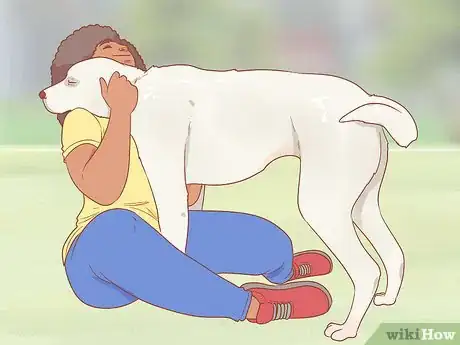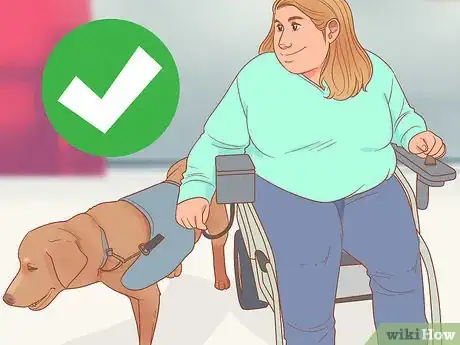This article was co-authored by wikiHow staff writer, Amy Bobinger. Amy Bobinger has been a writer and editor at wikiHow since 2017. She especially enjoys writing articles that help people overcome interpersonal hurdles but frequently covers a variety of subjects, including health and wellness, spirituality, gardening, and more. Amy graduated with a B.A. in English Lit from Mississippi College in 2011 and now lives in her hometown with her husband and two young sons.
There are 13 references cited in this article, which can be found at the bottom of the page.
This article has been viewed 30,682 times.
Learn more...
A service dog is one which is trained to assist people who have a physical disability, chronic illness, or neurological disorder. Under the Americans with Disabilities Act (ADA), a service dog must be allowed almost anywhere the public can go, including restaurants, housing and hotels, and on airplanes, since their owners depend on them for help with their daily activities.[1] If you have a disability, choosing the right service dog can make a meaningful impact on your quality of life.
Steps
Qualifying for a Service Dog
-
1Determine if you have a qualifying condition. If you have trouble walking, eating, sleeping, hearing, seeing, or performing day-to-day activities, you are likely to qualify under the ADA for a service dog. If you have any questions about whether or not your condition qualifies, ask your doctor or visit the ADA’s website for a list of qualifying conditions.[2]
- Conditions which may qualify a person for a service dog include vision impairment, hearing loss, PTSD, autism, diabetes, epilepsy, and multiple sclerosis (MS), among others.[3]
- For a seizure condition to qualify, the person must suffer an average of 1 seizure per month.[4]
- In order for hearing loss to be considered a qualifying condition under the ADA, a person must suffer 30% bilateral hearing loss.[5]
-
2Be able to participate in the training process. The process of training a service dog is involved, and it can require up to an hour a day. In order to ensure your service dog will be able to help you with your needs, you have to be able to commit to spending this time with the dog, even if they have already undergone training.[6]
- Formal training for a service dog usually lasts about 2 years before they are placed with their owner, but you will need to work with the dog for up to an hour a day for at least a 30 day trial period to help the dog to adjust to your individual needs.
Advertisement -
3Commit to caring for your service dog’s needs. Although your service dog will be helping you with your daily needs, you must also help them with theirs. Keep in mind that this even though your service dog is highly trained, they are still an animal. You will have to be prepared to care for the dog by providing it with food, water, exercise, and grooming.[7]
- If you have a dog with a high energy level, you will have to provide it with plenty of exercise and mental stimulation. Energetic dogs who become bored often find destructive ways to alleviate their boredom, such as chewing furniture. Practice teaching your dog new tricks and give them special toys designed to engage their mind and their senses.[8]
- If your dog becomes ill or injured, you will also need to be able to bring them to the vet. If your mobility makes this an issue, be sure you have a plan in place should your dog need medical assistance.
-
4Live in a stable home environment. All dogs, even service dogs, need stability in order to function properly. Your service dog will need a stable living environment in order to properly learn your mannerisms and the daily routines which are necessary to perform their duties.[9]
- If you expect to live in your home for a significant amount of time (or you can easily arrange for a new home if you decide to move) and your home is peaceful and safe, your environment is likely stable enough for a service dog.[10]
- Someone who is in a temporary living arrangement, who is homeless, or who lives in a toxic or abusive environment may not be able to adequately meet the needs of their service dog.
-
5Make sure any other pets you have are dog-friendly. Having another dog may change the pack dynamic of your household, depending on the animals. This can affect your service dog’s ability to perform their expected tasks. It is generally fine to have other animals as pets in the household, as long as they're dog-friendly.[11]
Choosing a Breed and Age
-
1Research dog breeds. Make a list of traits that are common to various dog breeds. Think about what you need based on your disability and your own preferences. Some qualities to consider include the dog’s temperament, intelligence, activity level, grooming needs, and their life expectancy.[12]
- Service dogs can be any breed, but Labrador Retrievers and Golden Retrievers are the most common breeds for service dogs. They like being around people, are easy to train, and have a tolerant temperament. Collies are also a common choice and are ideal, although you will need to commit to regular grooming of a Rough Collie. Collies also come in a short coat variety called Smooth Collies. They are generally less high-energy than either labs or goldens and easy to train.
- Do not assume a dog will be the exception to its breed traits just because you like that dog. Bully breeds, for instance, can be loyal and loving pets, but they often exhibit aggression towards other dogs, which will render them incapable of serving in public.[13]
-
2Choose the right size service dog for your needs. Decide whether you need a small, medium, or large breed dog. If you need physical support, you probably need a large dog. However, if you need to be able to carry your dog due to frequent travel, you might choose a small dog.[14]
- Most service dogs are larger breeds, since they are better equipped to retrieve items and provide mobility assistance. Smaller dogs may become overwhelmed in public or around loud noises, and if you have back problems or other limiting physical disabilities, it can be a challenge to bend down to pick up a small dog.
-
3Narrow your options to 2 or 3 breeds before you visit a handler. Once you’ve made your list of different breed traits and size requirements, narrow down your options to 2 or 3 dog breeds you think would be a good fit for you. This will give you some flexibility as you search for your service dog, but should not leave you with so many choices that you become overwhelmed.[15]
-
4Decide the age of the dog you are looking for. Think about the amount of time you expect to have with your service dog, as well as how much effort you want to put into training your dog. Younger dogs can be more challenging to train, but older dogs will likely begin to exhibit health problems as they age. Generally, older dogs will have drop-out rates, too, and some organizations that train your own dog to become a service animal won’t deal with dogs over a certain age. A young adult (about a year old) is often the best age for a first service dog.[16]
Selecting Your Service Dog
-
1Select an agency with a good reputation. Although you can train your service dog yourself, it’s a good idea to get your first one from a trusted agency. This will help you adjust more quickly to life with your new service dog. Read online reviews or talk to people you know to find an agency with a good reputation and a history of healthy, successful dogs.[17]
- Some agencies specialize in training dogs to deal with specific disabilities, while others train specific breeds or rescue dogs. No matter what type of agency you choose, be sure that they are confident that the dog's training enables them to provide you with the assistance you need.
- It's possible to train a dog you already have or to adopt a dog from a shelter and have that dog trained as a service dog. However, not all dogs are suited to be service animals. In fact, the dropout rate for dogs in training as service animals is about 50%.[18]
- Each agency will have its own list of application requirements, so be sure to go over those carefully before submitting your service dog application.
-
2Look for a dog that is calm, focused, and friendly. Try testing the dog’s sensitivity to loud noises as well as to being petted all over their body. Give the dog a few simple commands, such as “Sit” or “Come" to see if they are inclined to obedience. Also pay attention to whether or not the dog seems in good health and if they respond positively to any other people or dogs in the area.[19]
- Avoid dogs which demonstrate fear, aggressiveness, or suspicion towards people or other dogs.[20]
-
3Ask about the parents’ genetics. Meet the parents if it’s at all possible. Check their temperament and personalities as well as their physical traits. Ask if the dogs have been checked for any genetic disorders that may affect your service dog’s health later in life.[21]
-
4Trust your gut feeling. When it comes to choosing the right service dog for you, ultimately it comes down to the relationship between you and the dog. Make sure the dog fits the requirements you have, but then try to find one you feel a special connection with. You’ll be spending a lot of time together, so pick a dog with a personality you like![22]
-
5Buy what you'll need to bring the dog in public. Service dogs are not required to be registered or to wear any special credentials, but you will need to keep them on a leash when you're in public. You may also want to buy a vest showing that your dog is a service animal for easy identification.[23]
-
6Know your rights. You do not have to disclose to anyone else the nature of your disability, even if you bring your service dog into their home or business. In fact, business owners and their staff are prohibited by law from asking you about your disability. They can only ask you whether your dog is a service dog and what tasks it is trained to perform.[24]
Expert Q&A
-
QuestionHow would you train a dog to be a post-traumatic stress service dog?
 Elisabeth WeissElisabeth Weiss is a Professional Dog Trainer and owner of Dog Relations NYC, a dog training service in New York, New York. Elisabeth relies on science-based, force-free, and reward-based techniques. Elisabeth offers behavior training, puppy manners, body awareness and injury prevention, diet, exercise and dog nutrition services. Her work has been featured in New York Magazine and on the Dog Save the People podcast. She also trained all the dogs in the movie "Heart of a Dog" by Laurie Anderson that features Elisabeth's journey with Laurie Anderson's and Lou Reed's dog Lolabelle and how her passion for playing the keyboards played a significant role in improving her quality of life after being diagnosed with pancreatic cancer.
Elisabeth WeissElisabeth Weiss is a Professional Dog Trainer and owner of Dog Relations NYC, a dog training service in New York, New York. Elisabeth relies on science-based, force-free, and reward-based techniques. Elisabeth offers behavior training, puppy manners, body awareness and injury prevention, diet, exercise and dog nutrition services. Her work has been featured in New York Magazine and on the Dog Save the People podcast. She also trained all the dogs in the movie "Heart of a Dog" by Laurie Anderson that features Elisabeth's journey with Laurie Anderson's and Lou Reed's dog Lolabelle and how her passion for playing the keyboards played a significant role in improving her quality of life after being diagnosed with pancreatic cancer.
Professional Dog Trainer You can teach a dog to do pretty much anything that the human is comfortable with. It would be important for the dog not to react to adrenaline because I would think that a person with PTSD would produce a lot of adrenaline in certain situations. I would teach the dog that when they smell adrenaline, to go to the person who needs to be soothed.
You can teach a dog to do pretty much anything that the human is comfortable with. It would be important for the dog not to react to adrenaline because I would think that a person with PTSD would produce a lot of adrenaline in certain situations. I would teach the dog that when they smell adrenaline, to go to the person who needs to be soothed. -
QuestionIs there financial aid available for those who need a service dog but cannot afford one?
 Community AnswerYes, there are many organizations that offer reduced prices for service dogs, financial assistance, etc. I would recommend doing some online research for "service dog financial aid" to see if any of these organizations operate near you.
Community AnswerYes, there are many organizations that offer reduced prices for service dogs, financial assistance, etc. I would recommend doing some online research for "service dog financial aid" to see if any of these organizations operate near you. -
QuestionI'm under the age of 18 and suffer from several SSA-qualifying disorders for a service dog. How should I approach my parents with the idea if they don't think I need one?
 Community AnswerIf your parents don't think you need a service dog, convince them. It never hurts to put the idea out there. Make sure they know that you will be taking care of the dog's basic needs (walking, feeding, etc.). Once you've got the idea in their minds, explain to them in detail the problems that you have and how a dog would help you. Be sure you do lots of research and have answers ready to address any issues you think they might have.
Community AnswerIf your parents don't think you need a service dog, convince them. It never hurts to put the idea out there. Make sure they know that you will be taking care of the dog's basic needs (walking, feeding, etc.). Once you've got the idea in their minds, explain to them in detail the problems that you have and how a dog would help you. Be sure you do lots of research and have answers ready to address any issues you think they might have.
References
- ↑ https://www.ada.gov/service_animals_2010.htm
- ↑ http://usdogregistry.org/information/information-on-service-dogs/
- ↑ http://usdogregistry.org/
- ↑ https://www.pawswithacause.org/what-we-do/service-dogs
- ↑ https://www.pawswithacause.org/what-we-do/service-dogs
- ↑ https://www.pawswithacause.org/what-we-do/service-dogs
- ↑ http://www.thedogknowledgeservicedogfoundation.org/who-qualifies-for-a-service-dog/
- ↑ https://www.cesarsway.com/dog-training/obedience/6-great-ways-to-challenge-your-dogs-mind
- ↑ https://www.pawswithacause.org/what-we-do/service-dogs
- ↑ http://www.healthguidance.org/entry/14969/1/The-Basic-Needs-of-Every-Child.html
- ↑ http://www.thedogknowledgeservicedogfoundation.org/who-qualifies-for-a-service-dog/
- ↑ https://www.psychdogpartners.org/resources/getting-a-dog/choosing-the-right-dog
- ↑ https://growingupguidepup.org/choosing-service-dog-breed/
- ↑ https://www.anythingpawsable.com/picking-a-service-dog/
- ↑ https://www.anythingpawsable.com/picking-a-service-dog/
- ↑ https://growingupguidepup.org/choosing-service-dog-breed/
- ↑ http://www.shoreservicedogs.com/considering.shtml
- ↑ https://www.ncbi.nlm.nih.gov/pubmed/12738588
- ↑ https://www.anythingpawsable.com/picking-a-service-dog/
- ↑ https://www.anythingpawsable.com/picking-a-service-dog/
- ↑ https://www.anythingpawsable.com/picking-a-service-dog/
- ↑ https://www.anythingpawsable.com/picking-a-service-dog/
- ↑ https://www.ada.gov/regs2010/service_animal_qa.html
- ↑ https://www.ada.gov/regs2010/service_animal_qa.html
About This Article
To get a service dog, make sure you have a qualifying condition like vision impairment, hearing loss, PTSD, autism, diabetes, epilepsy, or multiple sclerosis. You also need to live in a stable home environment and be able to participate in the training process for your dog. Next, research the best service dog breeds to get an idea of what kind of dog you might want. Then, apply for a service dog and work with a trusted agency that has a history of healthy, successful dogs to find the perfect dog for you. To learn about ideal traits to look for in a service dog, read on!





































































